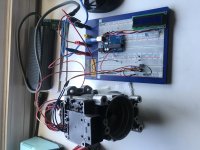Explain then, because from my knowledge (not saying I’m right) the only two electrical parts are 2 solenoids, 1 controlling timing, and one controlling fuel into the head. They are controlled by the “psg” which is told what to do via the ecm which is told what to do via numberous sensors and inputs.
Tell me where I’m wrong, because if that’s correct there’s no reason the timing solenoid couldn’t be run off a potentiometer to manually controll timing in a controllable but fixed timing, and the fuel solenoid could be controlled by eliminating 99% of the BS with a simple home made controller

